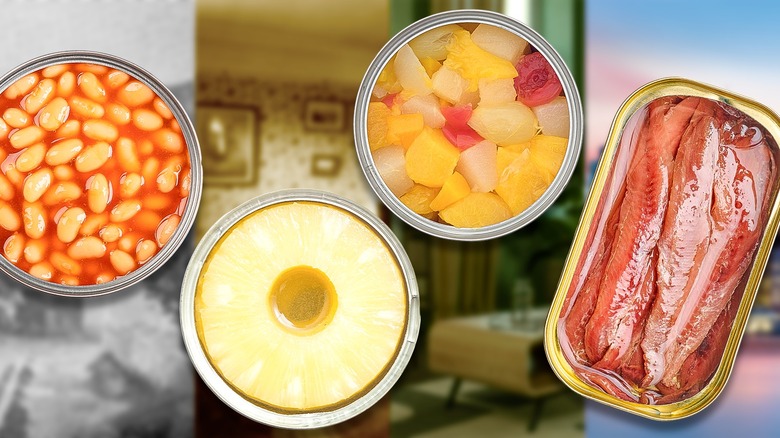
Static Media / Shutterstock / Getty
We may receive a commission on purchases made from links.
Canned foods have been sold commercially in the U.S. since the 1800s and are an irreplaceable pantry staple. By the end of the 19th century, canned foods' prevalence really started picking up. This led to certain canned items experiencing periods of trendiness through the ensuing decades.
Canned fish, soup, or veggies retain a baseline popularity, but they might not always be the canned food of the moment. Throughout the 20th century in particular, some canned foods spiked in popularity due to increased demand for shelf-stable foods. Canning perishable food and drink from fresh produce, to meat, to milk, offered a convenience previous generations hadn't known. At the same time, innovations like canned pasta and stew introduced the concept of a heat-and-eat meal made inside a can.
Not all canned foods that were once popular stayed that way long-term. Even the canning industry gets looped into fleeting fads, and some canned items that didn't stay popular faded into relative obscurity, or ceased to exist entirely. The millennial era ushered in a parade of canned novelty beverages — some caught on long-term, others were a flash in the ... can. Let's take a decade-by-decade look at the most popular canned foods and drinks from the last 135 years.
1890s: Baked beans
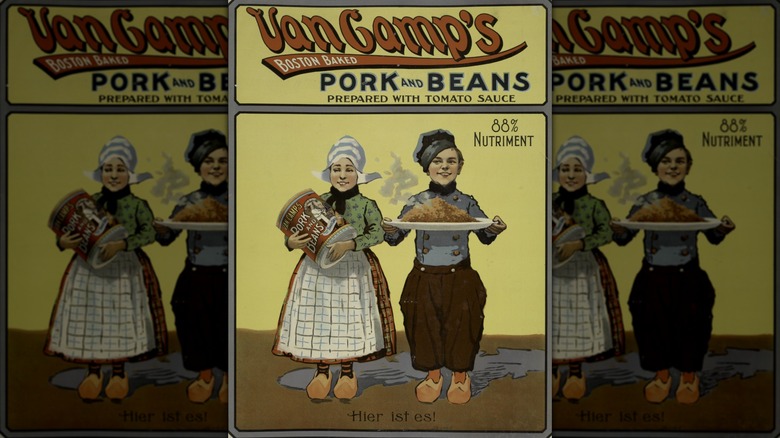
Heritage Images/Getty Images
Consider baked beans the godfather of commercial canned goods. American-style baked beans was a dish eaten by Indigenous peoples in the Northeast, long before canned goods were around. The practice of canning beans began around the 1860s, but Heinz was the first company to can baked beans on a commercial scale in 1895. Nine years earlier, the company's founder Henry Heinz sold a stash of canned baked beans to a luxury store in London, England while traveling abroad. This enterprising act laid the groundwork for Britain's baked beans obsession.
Heinz wasn't the only brand that sold canned baked beans in the 1890s. Indianapolis-based canner and grocer Van Camp had a bestseller on its hands with Van Camp's pork and beans. Van Camp sold its canned pork and beans in tomato sauce, a departure from the typical molasses-sweetened Boston baked beans recipe from New England. Van Camp's vigorous advertising efforts, beginning in 1890, helped the company to sell millions of cans of baked beans and opened multiple manufacturing facilities. Over a century later, Heinz baked beans and Van Camp's pork and beans are still sold.
1900s: Canned corn and peas
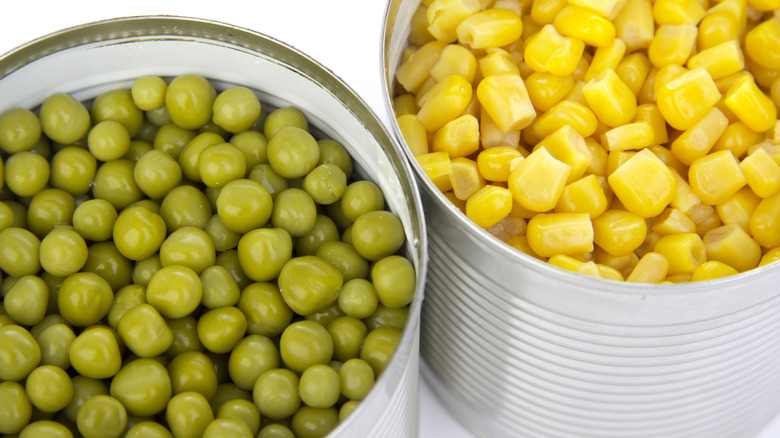
Ydefinitel/Getty Images
The Jolly Green Giant is an American icon and the veggies sold under the Green Giant banner have been popular with consumers since the early 1900s. Back then, Green Giant canned vegetables were the brand's big seller, particularly its corn and peas. Before it became known as the Green Giant Company, it was the Minnesota Valley Canning Company (MVCC), which was founded in 1903. It started as a collective of investors in Le Sueur, Minnesota who built a cannery in the hopes of capitalizing on the burgeoning canned food industry.
In those early years, MVCC struggled to secure a reliable leader to run the cannery. This made the company's initial output slow. By 1907, MVCC was only producing canned cream-style corn and canned peas. It would stay that way for the next three decades. Although the Green Giant moniker didn't come about until 1925, through the efforts of MVCC, the company was able to retain a foothold in the canned food market as it worked to define its brand. The Jolly Green Giant was created in 1936 and his effectiveness as a mascot was so undeniable, MVCC changed its name to the Green Giant Company in 1950. Green Giant canned corn remains a grocery store staple.
1910s: Canned shrimp
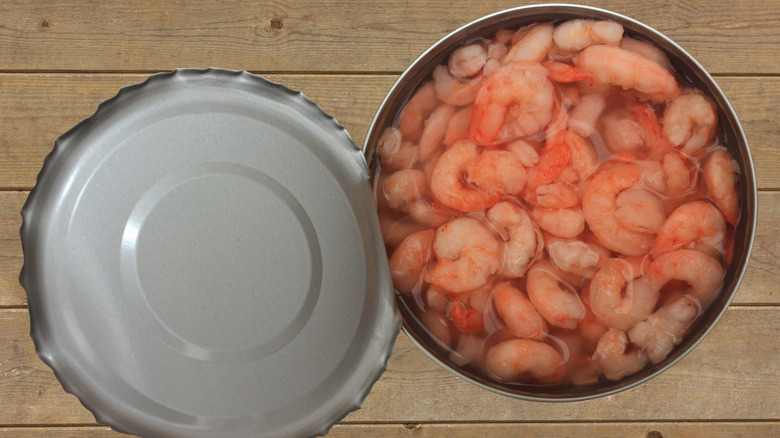
Nobtis/Getty Images
You don't see canned shrimp at every grocery store today, but in the 1910s it was one of the most convenient ways for people to enjoy the beloved shellfish. Refrigeration was still a few decades off, so canned foods in the 1910s had major domestic appeal. Larkin was one of the first brands to can shrimp for U.S. consumers. Popular recipes from this era that incorporated shrimp often called for the canned variety.
In order to preserve canned shrimp, the crustaceans are peeled, blanched, and trimmed. To prevent the shrimp from discoloring inside the can, the tin was lined with a thin veneer of enamel, husk, paper, or wood. In the 1910s, canned shrimp were fished from Gulf waters. Bumble Bee canned shrimp is one of the most prominent canned shrimp varieties remaining today. In modern times, the demand for fresh or frozen imported shrimp far outweighs the canned version that was popular in the 1910s.
1920s: Canned pineapple
In the 1920s pineapple was viewed as an exotic, exciting fruit that inspired people to get creative in the kitchen. As those of us with lackluster knife skills already know, fresh pineapple is a pain to cut, which made the pre-cut canned version rather alluring. In the 1920s, canned pineapple was a food reserved for the upper class.
Brands like Del Monte and Dole were some of the few companies that had access to pineapple farms in Hawaii, which didn't become a U.S. state until 1959. Del Monte's ancestral ties to the California Packing Corporation and the San Jose Fruit Packing Company made canning pineapple in the 1920s possible. Concurrently, the Hawaiian Pineapple Company of that era was owned by James Dole. Due to these companies' ability to procure and can pineapple, this tropical fruit became a shelf-stable commodity to mainland Americans. A recipe for Pineapple Upside-Down Cake hit the media at this time. The classic dessert and canned pineapple, have remained popular ever since.
1930s: Corned beef

Osarieme Eweka/Getty Images
Canned food was a lifesaver during the Great Depression. This dark period of American history began with the stock market crash on October 28, 1929 (known as Black Monday) and caused a desperate economic situation throughout the 1930s. Most families had to stretch a limited supply of food as far as it could possibly go. Canned corned beef played a big role in this type of eating and became a pantry staple of the Great Depression era.
Corn beef in a tin was made for hard times. It was a popular battlefield food for British soldiers during World War I. For civilians living through the Great Depression, corned beef was a protein source that was cheaper and more readily available than fresh beef or poultry. Some Great Depression foods were better than others, and the ones centered around canned corned beef had both high and low moments.
One of the canned corned beef recipes still being talked about is the corned beef luncheon salad. It calls for the corned beef to be combined with gelatin, canned peas, vinegar, and lemon juice, and pressed into a Jell-O mold. In 1932, Heinz printed a recipe for corned beef supper snacks. To make it, canned corned beef was chilled and thinly sliced to serve as the "bread" to house a filling of mashed Heinz baked beans, minced onions, Heinz chow chow pickles, and mustard sauce.
1940s: Canned soups and stews

Billy F Blume Jr/Shutterstock
The shadow cast by the Great Depression began to lift in the 1940s, but America's entrance into World War II came with food rations for the people back home. Canned food's history is inextricably linked to military-issued meals, and the soups and stews that were big in the '40s were no different. In support of the war effort, canned food in particular was rationed to conserve the use of tin.
Rations made the prospect of a one-can meal attractive to the average consumer. Americans were encouraged to can at home with produce grown from their own gardens (referred to as victory gardens at the time), but sometimes convenience won over. Campbell's condensed soups were huge around this time, as was beef stew from Dinty Moore.
Hormel Foods had been producing Dinty Moore beef stew since 1935. Its name was derived from the name of a fictional restaurant portrayed in a popular comic strip from the 1910s called "Bringing Up Father." There aren't a whole lot of people who remember the "Bringing Up Father" comic strip, but many people have old-time memories of Dinty Moore beef stew. This hearty meal of beef chunks, carrots, and diced potatoes retained its status as a quick-serve comfort food long after the war effort was through.
1950s: Del Monte fruit cocktail
Canned fruit was nothing new in the 1950s. Canned fruit cocktail, however, had a novel appeal with the '50s being America's first suburban decade, and the lifestyles of middle-class families evolving. Many women stayed home and raised children while their husbands worked, and part of homemaking involved grocery shopping and meal prep. From a marketing perspective, this created a huge opportunity for food brands to advertise products in a way that would make women want to try them out in the kitchen. Canned fruit cocktail fit the bill.
Del Monte, which was already known for its canned tropical fruits, is credited as the first brand to sell fruit cocktail. Golden Morn marketed canned fruit salad as early as 1893, but the version known as fruit cocktail is said to have been invented in 1930 by Herbert Gray of the Barron-Gray Packing Co. Del Monte had sold fruit cocktail since 1938, but it became even more popular in the '50s. The small pieces of pears, peaches, pineapple, grapes, and (maybe) a maraschino cherry packed in syrup provided boundless recipe inspiration.
Fruit cocktail was a convenient way to add sweetness and texture to a dish. Recipes for Ambrosia salad, Jell-O salad, and other '50s-era desserts often called for canned fruit cocktail. In time, the general consensus that fresh fruit was a healthier, higher-quality option took hold, and fruit cocktail began to gather dust on store shelves.
1960s: Sweetened condensed milk

Luen Wantisud/Getty Images
In the 1960s, sweetened condensed milk had a huge presence in the canned food section, but it had been around for quite awhile before then. Canned condensed milk was created in 1856 to combat the number of children that became ill or died from drinking contaminated fresh milk. Borden's innovation led to the Eagle Brand company producing cans of sweetened condensed milk to sustain soldiers during the Civil War. About 100 years later, sweetened condensed milk's popularity took a more well-rounded turn.
Sweetened condensed milk's usage in the 1960s fulfilled less urgent needs. By removing approximately 60% of milk's water content and supplementing it with sugar didn't just help preserve canned milk, it made the product ideal for use in household cooking and baking. Recipes like evaporated milk chocolate cake were big in the '60s. Eagle Brand continued to be a big sweetened condensed milk seller back then. Carnation, a brand that was also established in the 19th century, remains a leader in sweetened condensed milk production.
1970s: Canned pasta
Even if you weren't a child of the 1970s, you've probably dabbled in (or at least seen) canned pasta. The originator of canned pasta is Chef Boyardee and its inception occurred around 1928. Chef Boyardee was a real person whose real name was Ettore "Hector" Boiardi. He was an Italian immigrant who ran a restaurant in Cleveland, Ohio. Boiardi had a cutting-edge idea to start jarring his pasta sauce to go, and by World War II, he was tapped to make canned rations of sauced pasta for the U.S. Army. After what Chef Boyardee achieved, other companies jumped on the canned pasta bandwagon.
Another enduring type of canned pasta was SpaghettiOs. The "O" shaped noodles in tomato sauce were invented by Donald Goerke in 1965 and sold under the Campbell's Franco-American label. Longtime competitor Heinz also introduced canned spaghetti with meat and sauce around this time.
In the 1970s and beyond, canned pastas were largely marketed toward kids. Not only did these salty, saucy pastas placate fussy eaters, their low-maintenance preparation allowed older children to crack open a can and heat up a meal on their own. Eventually, concerns about heavily processed foods put a dent in canned pastas' popularity, but guilty pleasures like SpaghettiOs are still readily available in stores.
1980s: Easy Cheese
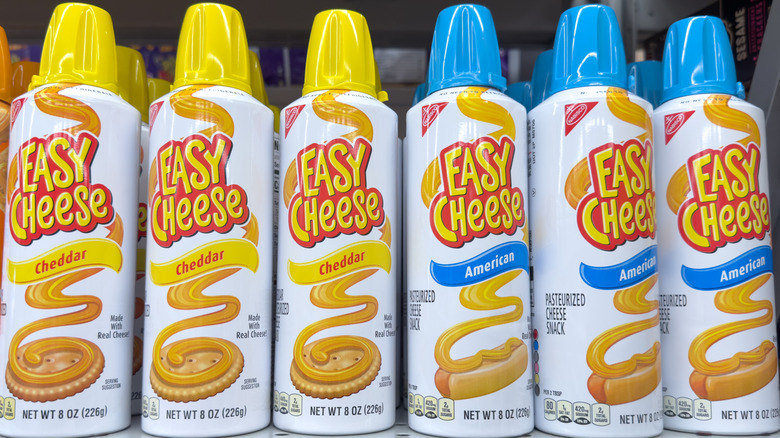
The Image Party/Shutterstock
Foods that were bright like the sun and remarkably shelf stable were right in step with the lifestyle trends of the 1980s. Canned spray cheese enjoyed a spike in popularity in the 1980s, but it was actually an invention of the 1960s. Nabisco was the first company to market canned spray cheese, under the product name Snack Mate. The utensil-free canned cheese made it easy to go around spraying cheese on absolutely anything your heart desired. Its success was modest at best. In 1984, Nabisco changed the product's name to Easy Cheese.
In a new decade with a new name, Easy Cheese integrated into pop culture more effectively than Snack Mate. For at least part of the '80s, Easy Cheese cans came with molds shaped like popular cartoon characters so kids could eat their cheese and crackers with a little more gusto. TV advertisements portrayed Easy Cheese as an ideal food for slackers who preferred to skip the crackers and spray the cheese into their mouths and pranksters who wanted to spray peers with Easy Cheese like it was Silly String. Ultimately, Easy Cheese's ultra-processed ingredients kept it from thriving in future, more health-conscious decades, but you can still grab a can here.
1990s: AriZona iced tea

Sheila Fitzgerald/Shutterstock
A huge, colorful can of iced tea for under a dollar was a huge hit in the '90s, and the first company to do it was AriZona. Don't take the brand name too literally, AriZona was created in Brooklyn, New York in May 1992. The family-owned business was started by Don Vultaggio, who named the tea after his affinity for Southwestern décor. Right from the start, Vultaggio sold the 24-ounce cans of iced tea for 99 cents in a bold effort to outsize and out-price Snapple.
AriZona iced tea was an immediate success. Within three years, the company sold 18 million cases. The original iced tea flavors were lemon and raspberry, but new additions like peach and mango rounded out the lineup in those early years. In 1996, AriZona introduced its Ginseng and Honey Iced Green Tea, which remains a bestseller for the brand.
AriZona's wave of success almost ended in the late '90s when Vultaggio's 50% business partner, John Ferolito, wanted to sell the company. Years were spent haggling in court before a settlement was reached, but AriZona is still going strong. It's still less than a dollar — but the can's size has been reduced to 22 ounces.
2000s: Energy drinks
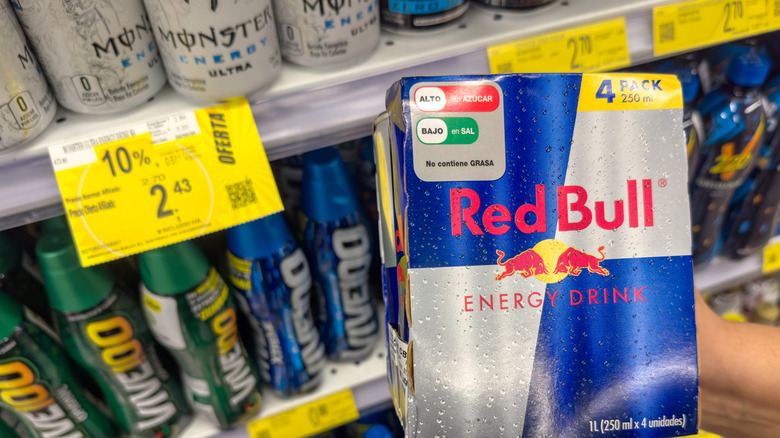
ALL TEXTURES/Shutterstock
Canned novelty beverages had some pep in their step in the 2000s, all thanks to a new wave of energy drinks that were having a moment in the new millennium. As a concept, energy drinks were decades in the making. Lucozade, a sparkling glucose drink from the 1920s was advertised as a way to replace lost energy. Lucozade never made a splash like Red Bull did.
Red Bull's origin story was a slow burn. It launched in Austria in 1987 as a European version of an energy-style drink from Thailand called Krating Daeng (translation: Red Bull). In 1995, Red Bull entered the U.S., but it was a 2003 marketing campaign that grabbed everyone's attention. The simple slogan, "Red Bull gives you wings" launched the energy drink into the mainstream. Meanwhile, Monster Energy, a derivative from the 1930s-era Hansen's soda company, was making its own gains in the energy drink segment. Monster became successful enough that Hansen's renamed its company to Monster Beverage Corporation.
Red Bull and Monster are the heaviest hitters of the 2000s energy drink trend, but there were more. Rockstar Energy was another big seller that's still around today. Some 2000s canned energy drinks that didn't stick around were Cocaine (I'm sure you can guess why), Pimp Juice (developed with rap artist Nelly), and Who's Your Daddy (yes, really).
2010s: Tinned anchovies
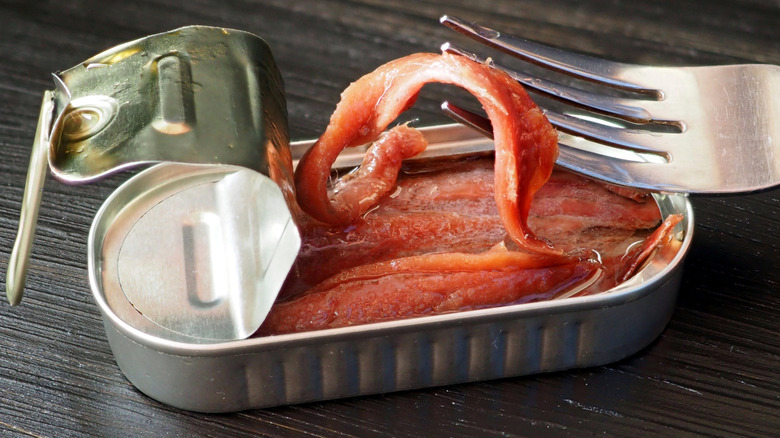
Nick Alias/Shutterstock
At last, canned anchovies are being appreciated for the salty little delights they've always been. In decades past, anchovies were a little misunderstood. Their reputation as a dreaded pizza topping caused some to discount anchovies altogether. In the 2010s, voices of reason resounded over these prior misconceptions and people realized that anchovies are actually delicious.
In Peru, consumption of anchovetas, a type of anchovy, increased from 10,000 metric tons in 2006 to 190,000 metric tons in 2010. The South American nation is a top global producer of fishmeal made from ground anchovetas, but as consumer demand for whole anchovetas soared, fisheries began to tin them instead.
In 2010, Spain's anchovy industry experienced a year-over-year market value increase of 7.3%. It was a high point for the Spanish anchovy market, which raked in $154 million that year. Yet for Spain, a leader in European anchovy production, a gradual decline permeated the remainder of the 2010s. By 2018, the market for preserved anchovies dipped to $128 million.
2020s: Canned tuna

Kinga Krzeminska/Getty Images
In many ways, tuna is the ultimate canned food. It's been on store shelves for over a hundred years, and its relevance is particularly strong in the 2020s. Canned tuna is simple, satisfying, and versatile, but per capita consumption levels were on the decline in the first two decades of the 21st century. Then came COVID-19. Panic-stricken consumers lined up outside grocery stores and when it was their turn to enter, many of them stocked up on tuna cans.
In 2021, 637.9 million pounds of tuna were imported into the U.S., and about 71% of the tuna was canned. The resurgence of canned tuna isn't without challenges. Today's consumers expect transparency when it comes to concerns like sustainably-caught fish and dolphin-safe canned tuna. A price-fixing scandal in the 2010s that saw Bumble Bee, Chicken of the Sea, and StarKist conspire to over-inflate the cost of canned tuna damaged consumer trust and resulted in hundreds of millions of dollars in penalties and class-action settlements. If canned tuna wants to retain its renewed popularity, maintaining high ethical standards is a must.



